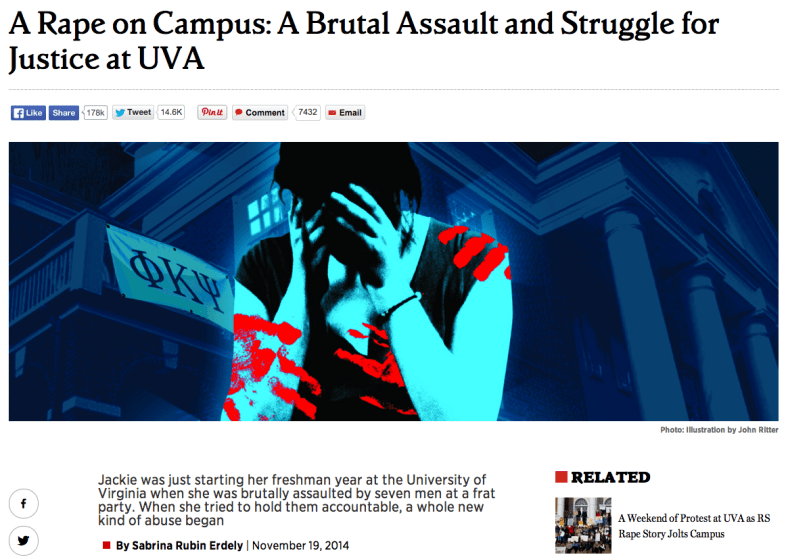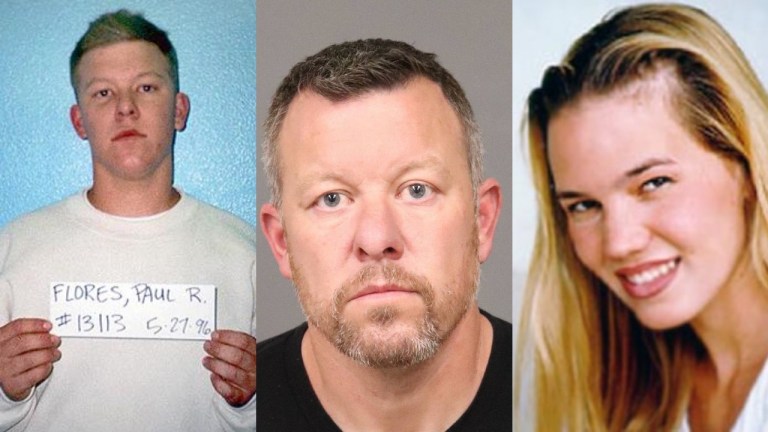Another Rape Story Conveniently Gets Sidelined
Sadly, a young woman’s rape story has once again been manipulated and even ridiculed by the global media.
By ![]() Viva Bianca
Viva Bianca


Sadly, a young woman’s rape story has once again been manipulated and even ridiculed by the global media. Now, as a result of unfortunate journalistic oversights, the very motivation behind the publication of the now controversial Rolling Stone article, A Rape on Campus: A Brutal Assault and Struggle for Justice at UVA by Sabrina Rubin Erdely—to reveal not only a brutal incident of rape in September 2012 at the University of Virginia, but also to expose the epidemic of unreported sexual assault that plagues UVA and repeatedly gets swept under the carpet—has been grossly overshadowed by a media war.
But let’s get back to the issue at hand and look at the cold, hard facts. While there’s evidence to suggest “discrepancies” in victim “Jackie’s” story, there’s little evidence to suggest that the rape never happened at all. In fact, on the contrary; the three friends who came to Jackie’s aid on the night of the rape all concede that Jackie was shaken, that something bad must have happened. It is also undeniable that since that night, Jackie became withdrawn, so anxious and depressed that she continues to take anti-depressants, that her grades dropped and she even failed a few classes, and that she gained 25 pounds. Jackie’s consequential involvement with One Less—an UVA sexual assault survivor network—along with her repeated visits to sexual assault advisor Dean Eramo’s office, in every way suggest that she was a survivor of serious sexual assault.
Jackie’s friends distancing themselves from her—as detailed in the revelatory Dec 5 The Washington Post article—should not be used as evidence against her, nor should their version of events and conversations with Jackie; The Rolling Stone article firmly established that above all, school loyalty and social climbing are what reign at UVA. Furthermore, The Washington Post interviewed these peers 2 years after the event. No doubt, their memories of an event which carried little weight in their lives (comparatively to Jackie’s) will be a little muddy.
Furthermore, how a statement from Phi Kappa Psi, the fraternity in question, can hold weight as evidence to discredit Jackie is questionable. Of course they’re going to fervently deny and defend themselves. Isn’t that the whole point of fraternities? “Brotherhood” and all that? And again, they’re operating in a culture where sexual assault routinely gets swept under the carpet, concealed and excused. The fraternity claim that they held no event that night. But other than their word, where’s the evidence to support that claim?
Part of the new-found scepticism surrounding Jackie’s story is that the main perpetrator described and named seems not to have belonged to Phi Kappa Psi as she so claims. And, as previously mentioned, Phi Kappa Psi claim not to have thrown an event that night at all. If that’s true, could it be possible that Jackie is confused about the fraternity house at which the rape occurred? After all, she was an 18-year-old freshman, only a few weeks into her first year at college.
What really frustrates me is that due to these “discrepancies,” including the amount of men she remembered to have raped her—Jackie’s friend told The Washington Post that when she first became friends with Jackie, Jackie claimed that she had been raped by 5 men, and then later she changed it to 7 men—Jackie’s story is now being ridiculed and dismissed. Firstly, as myself a victim of rape, I can honestly say that remembering finite details can be really hard; trauma can send your mind into a sort of comatose state and nothing seems real. That there was extreme violence also involved in Jackie’s nightmarish encounter only strengthens this theory. She was in survival mode, not in head-counting mode. The trauma and violence was in fact so extreme for Jackie that, as described by Erdely, “as he shoved the bottle into her, Jackie fell into a stupor, mentally untethering from the brutal tableau, her mind leaving behind the bleeding body under assault on the floor.” And we’re expecting the girl to have a sharp memory?? Secondly, whether she was raped by 5 or 7 men isn’t really the point. That she was gang raped at all is the point. And let’s face it, what’s the difference? By the time 5 men had penetrated her, would 2 more have made much difference? This is a horrible thing to write, but I hope the sentiment is clear.
The Washington Post also raised eyebrows about Jackie both showering and not contacting the authorities immediately after she was raped. As a survivor, I can also say that the last thing you think about after being raped is not taking a shower so as to preserve the ‘evidence’. Nor do you have police reporting on the mind. The very experience and aftermath of rape is one of complete disempowerment. To have made level headed and “empowered” choices in the movements following the incident is just unrealistic. These questions should really fall on Jackie’s friends who came to her aid that night. Apparently they went back to her dorm with her and spent the night; why did they not think to advise Jackie against showering? And why did none of them think to call the police?
What’s being overlooked here is that despite ‘discrepancies’—which there normally are when rape is involved because rape rarely happens in front of bystanders (ie. there’s rarely any witnesses)—a young woman was gang raped. And sexual assault, violence, and rape are all still too common in college culture. One of Rolling Stone’s key contributions with Erdley’s topical article, I believe, was to tell the world that this kind of thing happens a lot. And that the University of Virginia, an elite Ivy League university in the United States is not only a stomping ground for this kind of assault and sexual misdemeanour—fuelled by a fundamentally arrogant and misogynistic fraternity culture—but that the university actively prioritizes ‘saving face’ and ‘loyalty’ over protecting the safety of their students. ![]()




